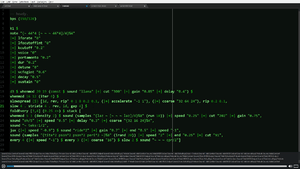TidalCycles
 | |
| Developer(s) | Alex McLean and others |
|---|---|
| Initial release | 2010 |
| Stable release |
0.8
/ 3 June 2016 |
| Operating system | Linux, Mac OS X, Windows |
| License | GPLv3 |
| Website | http://tidalcycles.org/ |
TidalCycles (also known as "Tidal") is a live coding environment designed for musical improvisation. In particular, it is a domain-specific language embedded in Haskell, focused on the generation and manipulation of audible or visual patterns.[1] It was originally designed for heavily percussive, polyrhythmic grid-based music, but now uses a flexible, functional reactive representation for patterns, using rational time.[2] Tidal may therefore be applied to a wide range of musical styles, although its cyclic approach to time[3] means that it affords use in repetitive styles such as Algorave.
In its native configuration, Tidal triggers samples on disk via a C-language sampler called Dirt . However there also exist integrations for MIDI,[4] and for the SuperCollider sound environment.[5]
References
- ↑ McLean, Alex. "Tidal – Pattern Language for Live Coding of Music". Sound and Music Computing. Retrieved 22 May 2015.
- ↑ McLean, Alex (2014). "Making Programming Languages to Dance to: Live Coding with Tidal". Proceedings of the 2Nd ACM SIGPLAN International Workshop on Functional Art, Music, Modeling & Design. FARM '14. New York, NY, USA: ACM: 63–70. doi:10.1145/2633638.2633647. ISBN 978-1-4503-3039-8.
- ↑ Aaron, Samuel; Orchard, Dominic; Blackwell, Alan F. (2014). "Temporal Semantics for a Live Coding Language". Proceedings of the 2Nd ACM SIGPLAN International Workshop on Functional Art, Music, Modeling & Design. FARM '14. New York, NY, USA: ACM: 37–47. doi:10.1145/2633638.2633648. ISBN 978-1-4503-3039-8.
- ↑ "tidalcycles/tidal-midi". GitHub. Retrieved 2015-05-25.
- ↑ "SuperCollider Users New (Use this!!!!) - Tidal and supercollider". new-supercollider-mailing-lists-forums-use-these.2681727.n2.nabble.com. Retrieved 2015-05-25.